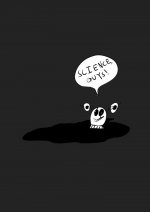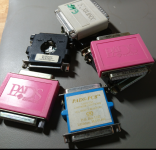I use KiCad for PCB layout of diyAudio hobby projects. I chose it rather than one of the stripped-down, feature-reduced, low cost versions of Eagle, because
The "competitive landscape" may have changed since ~ 2012 when I was deciding; I haven't been watching closely.
KiCad has no limits on board size
KiCad has no limits on number of layers
KiCad is free
KiCad has no limits on number of layers
KiCad is free
The "competitive landscape" may have changed since ~ 2012 when I was deciding; I haven't been watching closely.
Dan,
You got your brand name pat!
Loopy Goop
When I google for the goopster, I end up somewhere at twitter,
where someone cries for science:
Attachments
Ah, the usual denial. Part of running your audio business.Nah, your "FUD claim" so you have to bring the evidence that my post contained/was "FUD"; you surely remember "the burden of proof is on the claimant", don't you?
Your claim of what I wrote, minus the quote. Twisting and exaggerating, part of running your audio business.You were asking in the context of my post abot DF for listening test results; how could requesting informations what kind of listening test that should be, be evasive?
Exactly I don't post here with any audio busines interest.
Nah, as is wasn't evasive, just requesting the missing informations from you, could it be that you were fooling yourself again?
I have never tried Kicad or Nigel's s/w, but I have used quite a few of them, so I know what is good and what is crap. It does take a fair bit of time investment and sometimes cost, in each one to try out in order to make that call. Once you have used the more advanced pcb layout packages like Mentor and Cadence, then you can tell what others do or not do well.
I know that Nigel, is the developer and you can discuss his product directly with him, this is a unique situation. Not sure if it will sway him to add features, but bug fixes should probably happen faster than most others unless you pay for support and even then ...
I know that Nigel, is the developer and you can discuss his product directly with him, this is a unique situation. Not sure if it will sway him to add features, but bug fixes should probably happen faster than most others unless you pay for support and even then ...
I left ORCAD for Pads. I left PADS for Altium. Cadence was never an option.PCB work? Allegro Cadence or PADS. Then OrCAD in that orde
-RNM
Just yesterday I found some Orcad and Pads dongles in a forgotten drawer. Plus some Xilinx; they are no longer needed. Nowadays I would probably skimp on the $10K and go Kicad.
Gerhard
Attachments
When it is all said and done, it is the libraries that are the most important and for that all the stock libraries are limited because usually the people making them do not know what is required to make a good cad library footprint or for a manufacturing process. Like for instance having the correct properties/attributes to generate a BOM, so that loading up the BOM to a specific distributor's web site, is as seemly as possible. Libraries take a lot of time and effort, that is why switching s/w is not so easy as in most cases all that library work has to be done again. This is DIY so productivity is not so important but professionally it is because time to market is usually one of the goals.
Last edited:
until there are library errors and then all that time and $ -> the bin, been there, done thatlibraries may not be all that important.
I guess that depends on what "all" is?that can do it all.
Last edited:
Evidently the release copy is not dithered BUT that is the choice of the mastering team/producer
Not clear, it is supposed to be noise shaped dither. What their algorithm looks like in he time domain would need some thought.
I remember vaguely that there was some talk amongst people in the know about 20 years ago that something was broken in the Super Bit Mapping process back then. Broken as in doing more damage than good. Truncation? The recording is from the mid '90s, so this might be it.All that fancy gear.
I had access and used Altium's predecessor called AccelEDA, but the funny thing is that for my analog projects I draw all traces and copper pours by hand.I heard Altium is only ten grand, but I've seen a short demo, it's Teh Thing To Use when you have a 64-line data path between a high speed processor and memory, and need all the signals to "show up" at the same time. Might be overkill for audio projects.
I remember vaguely that there was some talk amongst people in the know about 20 years ago that something was broken in the Super Bit Mapping process back then.
Right, I never looked at the time domain behavior of different noise shaping algorithms but something about this seems strange. I'm no expert on this so I don't know what to expect. Simple TPDF dither looks like additive noise and has a white spectrum.
OK, found a snippet from 1999
>SBM has considerable quantization distortion
>because it is primarily a noise-shaping algorithm and not dithered.
>You can easily test for that with a fade-to-noise test tone signal.
Last edited:
It could be well Japanese business culture to "keep making lots of products, some will eventually sell and become profitable." I recall reading about Yamaha and Roland making many different models of music synthesizers and drum machines and such, many were forgotten but some became best sellers.
Much of it may be that Sony is such a big company and that so much of its business has been audio, both pro audio products (Sony made one of the first digital multitrack tape recorders) as well as consumer (remember the Minidisc?).
And of course the infamous My First Sony.
I wonder if Sony is the company that has had the largest number of different audio products on the market. Sony even sold music CDs with a rootkit.
Much of it may be that Sony is such a big company and that so much of its business has been audio, both pro audio products (Sony made one of the first digital multitrack tape recorders) as well as consumer (remember the Minidisc?).
And of course the infamous My First Sony.
I wonder if Sony is the company that has had the largest number of different audio products on the market. Sony even sold music CDs with a rootkit.
- Status
- Not open for further replies.
- Home
- Member Areas
- The Lounge
- John Curl's Blowtorch preamplifier part III

